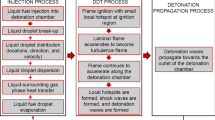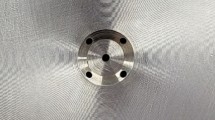Abstract
Liquid-fuel detonations or spray detonations are always of interest due to their important roles in several practical applications, such as explosion prevention in the presence of leakages occurring in liquid-fuel storage tanks and pipelines or the onset of two-phase detonations in developing detonation engines such as PDE or RDE. A PDE is a combustion system which relies on repetitive detonations that are cyclically initiated in a tube. Within one combustion cycle, the processes of fuel/air filling, detonation initiation, detonation propagation, and blowdown of burned products proceed sequentially. When liquid fuels are employed in PDEs, tremendous difficulties arise during the detonation initiation process due to the inherent insensitivity of droplet-air mixtures. To overcome this problem, high-vapor-pressure fuels (such as n-hexane and n-heptane) were adopted [1] owing to their rapid vaporization rates. Another strategy is to operate the liquid-fuel PDE mimicking a gaseous-fuel PDE by preheating the air and/or fuels [2]. Tucker et al. demonstrated liquid-fuel PDE operation up to 15 Hz with the inlet air heated to 123 °C or 149 °C, wherein different liquid fuels with varying volatility levels were preheated to 192/279 °C or even unheated. From a practical point of view, the fuel may coexist in both the liquid and vapor phases, especially at relatively low temperatures. It is well known that the choice of an appropriate equivalence ratio plays a vital role in ensuring the successful operation of a gaseous-fuel PDE. However, for the case of liquid-fuel PDE, the definition of the equivalence ratio becomes more ambiguous. It is possible to adopt a global (or overall) equivalence ratio based on the total amount of fuel or a vapor-phase equivalence ratio based only on the amount of fuel present in the vapor phase. It is of interest to experimentally investigate which definition of equivalence ratio is more relevant for the successful operation of liquid-fuel PDE.
Access provided by CONRICYT-eBooks. Download conference paper PDF
Similar content being viewed by others
Introduction
Liquid-fuel detonations or spray detonations are always of interest due to their important roles in several practical applications, such as explosion prevention in the presence of leakages occurring in liquid-fuel storage tanks and pipelines or the onset of two-phase detonations in developing detonation engines such as PDE or RDE. A PDE is a combustion system which relies on repetitive detonations that are cyclically initiated in a tube. Within one combustion cycle, the processes of fuel/air filling, detonation initiation, detonation propagation, and blowdown of burned products proceed sequentially. When liquid fuels are employed in PDEs, tremendous difficulties arise during the detonation initiation process due to the inherent insensitivity of droplet-air mixtures. To overcome this problem, high-vapor-pressure fuels (such as n-hexane and n-heptane) were adopted [1] owing to their rapid vaporization rates. Another strategy is to operate the liquid-fuel PDE mimicking a gaseous-fuel PDE by preheating the air and/or fuels [2]. Tucker et al. demonstrated liquid-fuel PDE operation up to 15 Hz with the inlet air heated to 123 °C or 149 °C, wherein different liquid fuels with varying volatility levels were preheated to 192/279 °C or even unheated. From a practical point of view, the fuel may coexist in both the liquid and vapor phases, especially at relatively low temperatures. It is well known that the choice of an appropriate equivalence ratio plays a vital role in ensuring the successful operation of a gaseous-fuel PDE. However, for the case of liquid-fuel PDE, the definition of the equivalence ratio becomes more ambiguous. It is possible to adopt a global (or overall) equivalence ratio based on the total amount of fuel or a vapor-phase equivalence ratio based only on the amount of fuel present in the vapor phase. It is of interest to experimentally investigate which definition of equivalence ratio is more relevant for the successful operation of liquid-fuel PDE.
In the 1980s, Lin et al. [3] used a predetonator to initiate clouds of decane droplets and air at 50 °C. They found that when the vapor-phase equivalence ratio to the global equivalence ratio ϕv/ϕ = 0.42, for which ϕ = 1.72 and ϕv = 0.72, spray detonation can be achieved, and it was an essentially gaseous detonation based on the measured detonation velocity. Note that ϕv/ϕ is identical to the percentage of vaporized fuel. In 2001, Brophy et al. [4] successfully initiated spray detonations in JP-10/air in a PDE in which a JP-10/oxygen predetonator was used. They obtained detonations for conditions where the inlet air temperature was higher than 102 °C, and more than 70 % of the fuel had vaporized, corresponding to ϕv/ϕ = 0.7. From these studies, it is fairly acceptable that the amount of fuel present in the vapor phase prior to detonation ignition has an important effect on heterogeneous spray detonations. However, the most pivotal factors for achieving successful spray detonations, e.g., ϕ, ϕv, or ϕv/ϕ, still remain unresolved. In this paper, a series of experiments performed on a Jet A1/air PDE with varying air temperatures and global equivalence ratios are conducted for this purpose.
Experiments and Results
First, experiments using a global equivalence ratio slightly above unity were carried out at a high inlet air temperature. This is to ensure the capability of the present experimental rig in successfully achieving detonations when the liquid fuels are fully vaporized. As shown in Fig. 1, when the global equivalence ratio ϕ = 1.17 − 1.21 and the air temperature is 186 °C, detonation transitions are observed. The PDE was fired in succession at a frequency of 2 Hz for nine times. Detonation transitions were attained in the tube for all nine firings, with 22.2, 33.3, and 44.4 % of the total transitions occurring at three different locations, respectively. The subsequent set of experiments was conducted at a relatively lower air temperature to evaluate the dependence of air temperature on the detonability.
As shown in Fig. 2a, at a relatively lower temperature where the global equivalence ratio was slightly above unity, successful detonations were not achievable. At T air = 167 °C, the maximum wave velocity at the last measurement location was only 1500 m/s. However, when the global equivalence ratio was subsequently increased to yield a more fuel-rich mixture, corresponding to ϕ = 1.57–2.0, detonations were obtained as long as T air ≥ 152 °C. This implies that an increase in the global equivalence ratio has enabled the onset of detonation to occur at a relatively low temperature.
Finally, experiments were conducted at relatively low temperatures with the global equivalence ratio increased to extremely high values. As shown in Figs. 3 and 4, as the air temperature was gradually reduced, the global equivalence ratio was increased to extremely high values. To our surprise, the Jet A1/air PDE was able to operate successfully for the entire range of air temperatures, even though the air temperature was only 70 °C. The measured wave velocities for all shots were in the range of 1790–1967 m/s. These results indicate that the use of extremely high global equivalence ratios is favorable for attaining spray detonations at relatively low temperatures. Using the NIST phase equilibria code SUPERTRAPP, the vapor-phase equivalence ratio corresponding to the global equivalence ratio at different temperatures can be calculated. The question arises as to whether phase equilibrium is established during the fuel filling time. During the testing, the droplet diameter was maintained at a SMD of 10 μm for a total of 22 shots. Applying a simple D 2 law, the equilibration lifetime to reach ϕv = 1.35 is estimated to be approximately 0.00122 s. This value of equilibration lifetime is much less compared to the filling time for the present testing conditions. Therefore, it is likely that phase equilibrium is established during the testing. From Fig. 4, we can find that the use of extremely high global equivalence ratios at relatively low temperatures actually leads to a corresponding vapor-phase equivalence ratio ϕv lying in the range of slightly above unity (Fig. 5).
As the previous studies [3, 4] focused on the role of the fraction of vaporized fuel on spray detonations, the fractions of vaporized fuel (or ϕv/ϕ) in our final experiments are estimated (see Fig. 6). Corresponding to shots 1–7 and 9, the fuel has fully vaporized and thus ϕv/ϕ = 1. When a relatively low air temperature is applied, a cool saturated fuel in the vapor phase (ϕv/ϕ < 1) is present. In this experiment, even when the fraction of vaporized fuel is as low as 0.3, successful liquid-fuel PDE operation is still accomplished, which can be attributed to the vapor-phase equivalence ratio attaining a composition that is easier to undergo detonation. From Figs. 4 and 6, it is realized that the amount of vaporized fuel sufficient for spray detonations depends not only on the mixture/air temperature but also on the global equivalence ratio being applied. Comparing to the existing data from the available literature [1, 3, 4] (see Fig. 7), successful detonations were achieved when ϕv of the liquid fuel was near stoichiometric or slightly fuel-rich. This indicates that the vapor-phase equivalence ratio plays a pivotal role in ensuring the successful operation of liquid-fuel PDEs. One could thus elevate the air temperature, increase the global equivalence ratio, or use a highly volatile liquid fuel to attain a suitable vapor-phase equivalence ratio. To quantitatively ascertain the amount of vaporized fuel which is present in the mixture of reactants and thus to obtain an appropriate vapor-phase equivalence ratio, an in situ optical diagnostics technique for quantifying the concentration of vaporized liquid fuel is currently under development.
Conclusions
Based on a series of experiments, it has been shown that the vapor-phase equivalence ratio plays a pivotal role in ensuring the successful operation of liquid-fuel PDEs. Based on the existing data from the literature and the present study, successful detonation experiments using liquid fuels are generally achieved when the vapor-phase equivalence ratio is near stoichiometric or slightly fuel-rich. At a relatively low temperature, an increased global equivalence ratio would thus be favorable for achieving an appropriate vapor-phase equivalence ratio.
References
Frolov, S.M.: Liquid-fueled, air-breathing pulse detonation engine demonstrator: operation principles and performance. J. Propuls. Power 22(6), 1162–1169 (2006)
Tucker, K.C., King, P.I., Schauer, F.R.: Hydrocarbon fuel flash vaporization for pulsed detonation combustion. J. Propuls. Power 24(4), 788–796 (2008)
Lin, Z.C., Nicholls, J.A., Tang, M.J., Kauffman, C.W., Sichel M.: Vapor pressure and sensitization effects in detonation of a decane spray. Twentieth Symposium International on Combustion, pp. 1709–1716 (1984)
Brophy, C.M., Netzer, D.W., Sinibaldi, J., Johnson, R.: Detonation of a JP-10 aerosol for pulse detonation applications. Book: High-Speed Deflagration and Detonation, pp. 207–222 (2001)
Author information
Authors and Affiliations
Corresponding author
Editor information
Editors and Affiliations
Rights and permissions
Copyright information
© 2017 Springer International Publishing AG
About this paper
Cite this paper
Li, J., Juay, T.C., Li, L., Lim, K.S., Khoo, BC. (2017). Investigations of Equivalence Ratio on Operational Liquid-Fuel Pulse Detonation Engines. In: Ben-Dor, G., Sadot, O., Igra, O. (eds) 30th International Symposium on Shock Waves 1. Springer, Cham. https://doi.org/10.1007/978-3-319-46213-4_81
Download citation
DOI: https://doi.org/10.1007/978-3-319-46213-4_81
Published:
Publisher Name: Springer, Cham
Print ISBN: 978-3-319-46211-0
Online ISBN: 978-3-319-46213-4
eBook Packages: EngineeringEngineering (R0)











